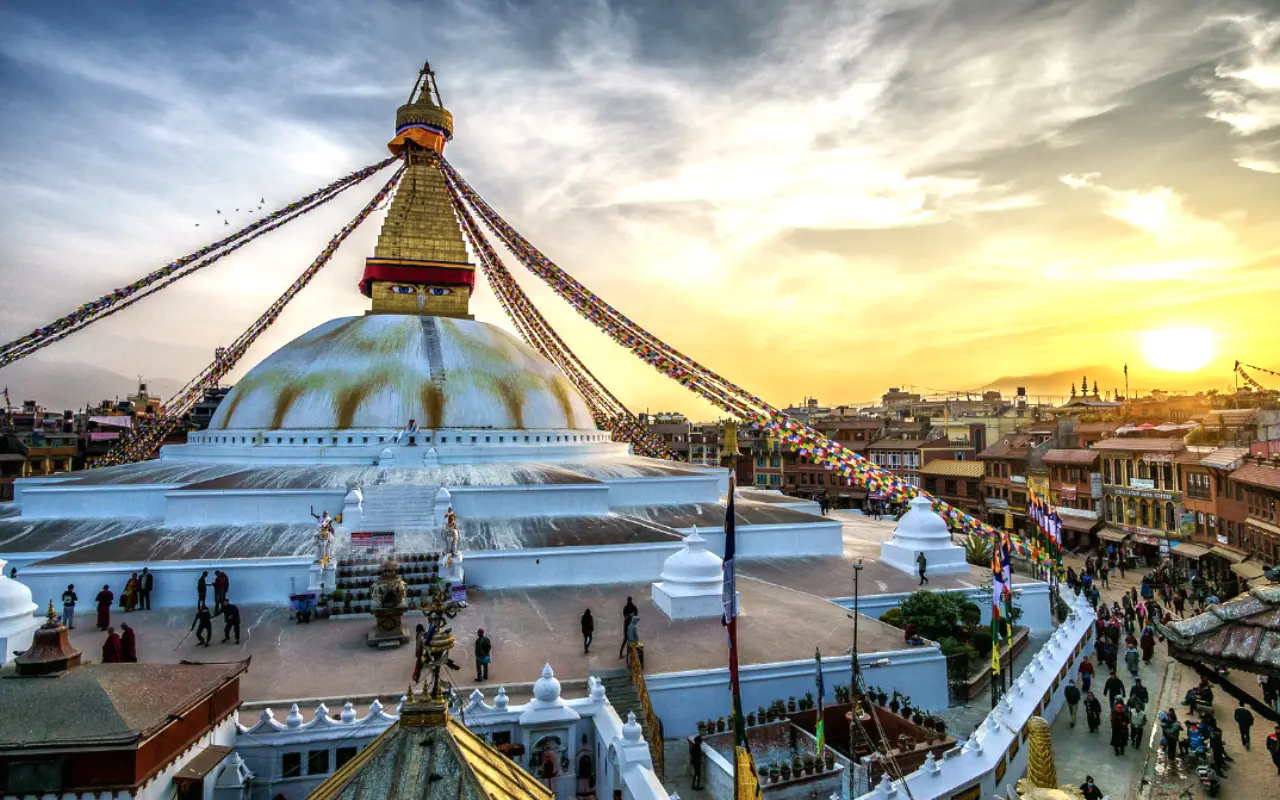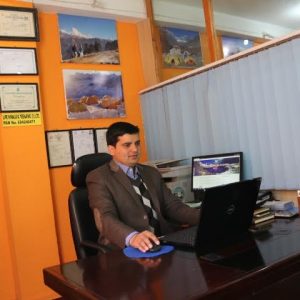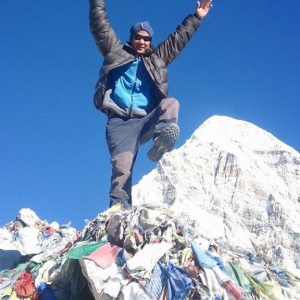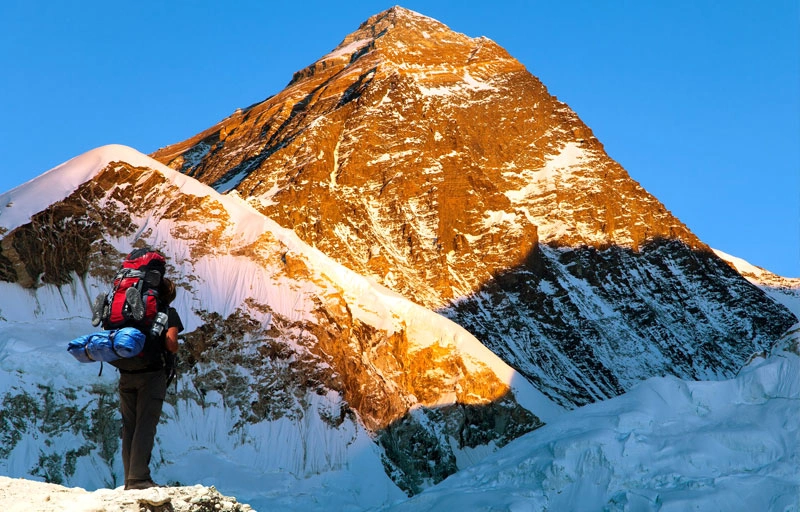Top 10 Iconic Landmarks in Nepal, You Must Visit in 2026
Nepal, a country nestled in the lap of the Sangrila Himalayas, is a destination that merges natural grandeur with profound spiritual and cultural richness. From the towering “roof of the world” of Mount Everest to the peaceful birthplace of Lord Buddha, Nepal is home to countless landmarks that captivate travelers worldwide.
As 2026 approaches, here’s your ultimate travel guide to the Top 10 Iconic Landmarks in Nepal that you absolutely must visit. Whether you are a trekker, a spiritual seeker, or a culture enthusiast, these spots offer unforgettable experiences.
Top 10 Iconic Landmarks in Nepal
1. Mount Everest Base Camp (EBC)

Location: Solukhumbu District, Khumbu Region
Elevation: 5,364 meters (17,598 feet)
Best Time to Visit: April–May & September–November ( however, to avoid high traffic, EBC Trek can be done throughout the trek in all four seasons, especially during December for snowy weather and monsoon for greener flora and animal sightings.
No landmark defines Nepal better than the majestic Mount Everest, the world’s highest peak. Trekking to Everest Base Camp (EBC) is a dream for many adventurers.
We, Life Himalaya Trekking, offer an experience, not just a tour package. The journey itself is more than just a hike—it’s a spiritual pilgrimage through the heart of the Himalayas. Along the way, travelers pass through scenic Sherpa villages, Buddhist monasteries, yak pastures, and rhododendron forests. Cultural immersion is just as compelling as the natural beauty.
Highlights:
- Panoramic views of Everest, Lhotse, and Ama Dablam
- Tengboche Monastery, one of the oldest in the region
- Sherpa Culture, Unique Festivals, Rituals, and Daily Lifestyle
- Kalapathar, 5545meters, the highest point reachable in Nepal, without a climbing permit
- Namche Bazaar, a bustling Sherpa town full of cafes, markets, and museums
Why Everest Base Camp in 2026?
With infrastructure improvements along the Lukla route, better service, and digital trekking permit systems in place, 2026 is the ideal time to go. The trek has become safer and more sustainable.
Pro Tip: Acclimatization is key. Spend an extra day in Namche and/or Dingboche to prevent altitude sickness.
2. Pashupatinath Temple

Location: Kathmandu
UNESCO Status: World Heritage Site
Best Time to Visit: All around the year,
Pashupatinath is one of the holiest Hindu Temples. It is a temple dedicated to the Hindu Lord Shiva; however, there are many small temples surrounding the temple dedicated to different Hindu deities.
It’s a sacred site with living cultural heritage and beliefs. Golden Roofs, Shrines, Ghats, and Ashrams situated across the Bagmati River make the Temple Area a spiritual place to witness various cultural and spiritual experiences.
Highlights:
- Evening aarti (ritual ceremony) with chanting, fire, and devotion
- Hindu cremation rituals that offer a glimpse into the cycle of life and death
- Hundreds of small temples and lingams
Cultural Significance:
Hindu Pilgrims travel from India, Sri Lanka, and even Bali to pay homage here. During the annual Maha Shivaratri festival, over a million devotees gather for one night of devotion. Not only that, the cremation and Evening aarti is a spiritual experience to watch for all nationalities and religions from all around the world.
Did You Know?
Non-Hindus aren’t allowed inside the main temple, but still, all the trekkers can explore the surrounding area freely and witness the atmosphere.
3. Boudhanath Stupa

Location: Kathmandu
UNESCO Status: World Heritage Site
Best Time to Visit: All around the year.
Boudhanath is one of the most calming, peaceful, awe-inspiring, and one of the Top 10 iconic landmarks in Nepal; you must visit in 2026. Boudhanath is the spiritual hub for Buddhism. The stupa, the meaning, and the symbol of the Stupa leave the visitors in spiritual awakening and a sense of calm.
One can enjoy the rooftop view from the surrounding restaurants and observe the morning sip of coffee or a cozy evening dinner.
Highlights:
- Spiritual ambiance with monks chanting and devotees circumambulating (walking around the stupa)
- Traditional praying flags hanging and wax-lamp lighting inside the adjacent monasteries
- Rooftop cafes offering stunning views of the stupa
Festivals to Catch:
- Lhosar
- Buddha Jayanti
Experience Tip: Visit early in the morning or in the evening, when monks and local devotees chant “Om Mane Padme Hum” and other chants.
4. Swayambhunath Stupa (Monkey Temple)

Location: Kathmandu
Best Time to Visit: All Around the Year
Overlooking the Kathmandu Valley from a Hillock, Swayambhunath is a center of history, mythology, and breathtaking views of the Kathmandu Valley and surrounding hills. According to Tibetan and Buddhist legends, the site was a mysterious blooming lotus that bloomed in the lake that once filled the valley.
Unique in its relevance to both the Hindu and Buddhist communities, it is a place of unity. It shows the diversity of Nepal, and shows how the people live in harmony when they share such beliefs and live in a peaceful and harmonious environment.
Highlights:
- White Dome-Shaped stupa with golden Shrine and Buddha Eyes
- Steps climb offering panoramic city views
- The troops of monkeys found are also called the guardians of the temple, hence the name “Monkey Temple.”
Architecture Note:
The temple complex includes a mix of Buddhist and Hindu shrines, making it a truly syncretic religious site with eyes, symbolizing that Buddha is watching over all of us and judging right from wrong and good from evil.
Visitor Tip: Don’t miss the small museum and local shops nearby for some cultural souvenirs.
5. Bhaktapur Durbar Square

Location: Bhaktapur, 14 km from Kathmandu
UNESCO Status: World Heritage Site
A living museum, Bhaktapur boasts one of the most preserved heritage sites among all three ancient city-states in the valley. Its brick and cobbled streets, red brick buildings, and artisan workshops create a time-travel experience for visitors.
Indulge in a pottery experience in a small local shop with true local people from the area on a pottery making session.
Highlights:
- Nyatapola Temple, a five-story pagoda
- 55-Window Palace
- Dattatreya Square and traditional woodcarving shops
Why Visit in 2026?
Restoration efforts following earthquakes are now largely complete, along with local government reforms, making 2026 the best time to experience Bhaktapur’s grandeur in its revived and well-maintained state.
Cultural Insight:
Don’t miss the famous Juju Dhau (also known as King Curd) – a sweet yogurt served in clay pots.
6. Lumbini: Birthplace of Lord Buddha

Location: Rupandehi District, southern Nepal
UNESCO Status: World Heritage Site
Lumbini is not just a site—it’s a global pilgrimage destination. It is the birthplace of Siddhartha Gautama in 623 BC, who became the Gautama Buddha and the pioneer who developed Buddhism. The area is now an international center of peace and learning.
Highlights:
- MayaDevi Temple and the sacred garden
- The Ashoka Pillar, erected by the Mauryan Emperor Ashoka, is a historical and archeological site.
- Monastic zones built by different countries, each showcasing unique architecture
Spiritual Tip:
Spend a day walking the tranquil lanes between monasteries and meditating near the sacred pond where Queen Maya bathed before giving birth.
7. Patan Durbar Square

Location: Lalitpur (Patan), within Kathmandu Valley
UNESCO Status: World Heritage Site
Patan is often overshadowed by Kathmandu and Bhaktapur, but its beauty lies in the details of its unique art and architecture.
Highlights:
- Krishna Mandir, built from a single stone
- Golden Temple (Hiranya Varna Mahavihar), a functioning monastery
- Patan Museum, showcasing medieval bronze statues and sacred art
Cultural Vibe:
Patan feels more local and intimate, and its narrow walkways and alleys lead to secret courtyards, water spouts, and artisan homes.
8. Annapurna Base Camp (ABC)

Location: Annapurna Conservation Area
Elevation: 4,130 meters (13,549 feet)
For those seeking a medium-level trek that combines natural beauty, culture, accessibility, and epic views, ABC is unbeatable. The trek is typically 7-10 days long and features tea-house stays, warm local hospitality, and varied scenery.
Highlights:
- Annapurna I and Machapuchare (Fishtail Mountain)
- Passing through Chhomrong, Bamboo, and Deurali
- Jhinu Danda hot springs
Wildlife to Spot:
Langurs(monkey), Himalayan monals, and occasional leopards
Sustainability Note:
ABC lies within a conservation area Annapurna Conservation Area; trekkers are encouraged to minimize waste and use refillable bottles.
9. Pokhara

Location: Kaski District
Pokhara offers a perfect blend of tranquility, peace, and adventure. Pokhara is the city of lakes, especially known for the amazing view of Annapurna and Machhapuchhre massif and the reflection of those ranges on Phewa Lake.
There are 7 major lakes in Pokhara, while Phewa Lake, Begnas, and Rupa Lake are the most popular. Phewa Lakeside is the tourist hub with major restaurants, bars, and pubs. Begnas and Rupa are a little away from the city center and are best for calm, nature-loving loving and those who love less crowded areas.
Whether you’re an adventure lover, a nature lover, or just there for a short time, sitting over the lake or sipping coffee with a mountain view, the city delivers it all
Highlights:
- Phewa Lake and Tal Barahi Temple
- Peace Pagoda (Shanti Stupa)
- Davis Falls, Bat Cave, and Mahendra Cave
Adventure sports: paragliding, hot air balloon, bungee jumping, zip-lining, ultra-light flights
Why Visit in 2026?
With new hotels, lake clean-up projects, and international events being held in Pokhara, the city is more welcoming than ever.
10. Chitwan National Park

Location: Southern Nepal, Terai region
UNESCO World Heritage Site: Since 1984
Best Time to Visit: Jan – Mid June, August-December
Chitwan is Nepal’s first national park and the first to be a World Heritage Site of Nepal. It offers the best jungle safari, luxurious stay, and relaxing experience in the plains of Nepal and is home to:
- Royal Bengal tigers
- One-horned rhinoceros
- Wild elephants, sloth bears, gharials, and over 500 bird species
Activities:
- Jeep and canoe safari
- Elephant breeding center visit
- Tharu village cultural shows
- Birdwatching in buffer zones
- Nature walks with expert guides
The Chitwan Jungle Tour offered by Life Himalaya includes all the activities mentioned above.
Cultural Tip:
Stay in Sauraha or Meghauli and explore the vibrant Tharu culture, known for their traditional dance, stick fighting, and unique housing style.
Final Thoughts
Nepal’s iconic landmarks offer something for everyone—the thrill of the Himalayas, the peace of spiritual sites, and the allure of historical cities. From trekking adventures to meditative retreats, each landmark holds a deep meaning in the cultural and natural landscape of the country.
Whether you’re coming for the mountains, the monasteries, or the museums, 2026 is the year to experience Nepal in its full glory.
When to Visit These Landmarks in 2026
Nepal has four primary travel seasons:
Spring (March–May):
Best for trekking (EBC, ABC)
Rhododendron forests in bloom
Festivals like Holi and Buddha Jayanti
Autumn (September–November):
Clear skies, stunning mountain views
Major festivals like Dashain and Tihar
Winter (December–February):
Best for city exploration (Kathmandu, Bhaktapur, Patan)
Snow in higher altitudes, quieter trails, best for off-beaten treks.
Summer (June-July)
For endangered animal sightings (Bengal tiger, one-horned rhino), best for city tours and Jungle Safari
Offbeat Alternatives Near the Landmarks.
If you love going off the beaten path, here are nearby hidden gems you can add to your landmark trip:
Near Everest Base Camp:
- Gokyo Lakes Trek: Less crowded, equally stunning glacial lakes and mountain views, the best off-beaten path trek in the Everest Region.
- Mera Peak Climbing: Best for beginners and moderate climbers for peak climbing experience in a trekking peak, best for preparation for higher peaks, or trekkers who want to experience a technical yet easy climbing experience.
Near Pokhara:
- Begnas Lake: A quieter alternative to Phewa, ideal for kayaking and sunrise views
- Australian Camp: Short trek with Himalayan views—great for families
Near Lumbini:
- Kapilvastu: The ancient capital of the Shakya kingdom, where Prince Siddhartha spent his early life
- Tilaurakot Palace Ruins: Ongoing excavations tied to Buddha’s Life
Taste of Nepal: Local Dishes to Try at Each Landmark
Your landmark journey wouldn’t be complete without diving into Nepalese cuisine. Here’s what to eat where:
A list of locations and their must-try dishes
- Kathmandu Valley: Newari Samay Baji (rice, meat, pickle combo)
- Bhaktapur: Juju Dhau (King of Yogurt)
- Pokhara: Thakali Khana Set (dal (lentils, bhat, meat, gundruk)
- Everest Region: Sherpa Stew (thukpa-style Noodle soup)
- Lumbini: Terai-style Litti Chokha & Sattu (powdered grains mix) drink
- Annapurna Region: Gurung-style roti, millet beer (tongba)
- Chitwan: Ghongi (freshwater snail)
Top Photo Spots in Nepal to Boost Your Travel Feed
If you’re looking to share your journey on Instagram or keep travel memories, don’t miss these picture-perfect spots:
- Everest Region: Kala Patthar (EBC), Namche Bazaar, Everest View Hotel, Lukla Airport, Nakarsyang Hill, Dingboche)
- Boudhanath Stupa: aerial rooftop view with prayer flags
- Pokhara: Phewa Lake, World Peace Stupa, Pokhara, Sarangkot Sunrise, Pumdikot
- Bhaktapur Nyatapola Temple: traditional architecture with the Himalayas in the background
- Chitwan: Jungle Safari, Canoe Ride, Gharials and One-horned Rhino
Cultural Etiquette & Local Tips
Respecting local customs enhances your travel experience and fosters goodwill with locals. Here are key tips:
Do:
Greet with “Namaste” (hands together, slight bow)
Dress modestly, especially in temples and villages
Ask permission before photographing people
Use your right hand for eating or handling objects
Avoid:
Public displays of affection
Entering temples with shoes or leather items
Pointing feet toward religious objects
Touching someone’s head (seen as sacred)
Sustainable Travel: Leave No Trace in Nepal
As Nepal’s tourism grows, so does the need for responsible travel. Here’s how you can help:
- Carry a refillable water bottle (use purification tablets or filters)
- Avoid single-use plastics on treks
- Support locally-run lodges and guides
- Don’t disturb wildlife or sacred rituals
- Follow waste-back policies on trekking routes
- By respecting nature and culture, you ensure that future generations can enjoy these same landmarks.
Our Efforts for Sustainable Tourism in Nepal
Life Himalaya Trekking has started sustainable tourism practices from 2025, starting with planting one tree for each traveller with us. We also provide garbage bags to guides, porters, and interested guests, so that we can start an initiative to preserve, protect, and promote the landmarks and trails of Nepal and increase awareness through the grassroots level for a new industry standard.
Final Checklist Before You Go
- Passport valid for 6+ months
- Travel insurance, and add-on helicopter rescue coverage (for trekking)
- Equipment List for trekking
Conclusion: Why Nepal in 2026?
2026 is a perfect year to visit Nepal. With tourism infrastructure improved, cultural sites restored, and sustainability efforts strengthened, the blend of ancient and adventurous is more accessible than ever. Whether you’re a first-timer or a returning traveler, Nepal’s iconic landmarks will captivate your heart and soul.
Make this the year you wake up to Everest, meditate in Lumbini, and sip tea with a Himalayan sunset.
Best Itineraries to Visit All 10 Iconic Landmarks in Nepal
12 days Everest Base Camp Helicopter Trek (includes EBC, Boudhanath, Kathmandu Durbar Square, Swayambhunath, and Pashupatinath)
Annapurna Base Camp Trek (Pokhara and ABC)
Nepal Culture Tour (Chitwan, Pokhara, Kathmandu Durbar Square, Boudhanath, Swayambhunath, Pashupatinath, Patan, Bhaktapur, Lumbini)
Start planning your Nepal adventure today!
Need help building a custom itinerary? Drop your travel goals in our email [email protected] or visit our website www.lifehimalayatrekking.com for more details on each package.
Writer Mr Shiba Hari Rijal,
I have been working in the Tourism sector for 03 decades (31 years to be exact). I have been organizing trekking, climbing, and touring as a porter, guide, and now as a managing director.
Along with that, my team and I have been contributing to local communities, repairing and building new schools, and different CSR projects, planting trees, and keeping the industry moving towards a sustainable path.
In the trekking sector, we also focus on improving the local economy, using only local guides and porters to improve the quality of life of the local people.





